Australia
Australia new 20-dollar note (B232) confirmed
14 10, 2019 07:54 Category: Oceania
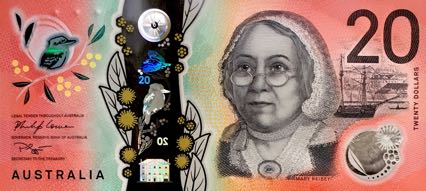

Courtesy of KK Lim ().
Australia new 50-dollar note (B233a) contains typo in microprint
09 05, 2019 08:28 Category: Oceania
According to various sources, the new 50-dollar note (B233a) issued on 18 October 2018 contains a typo in the microprinting. Specifically, the back of the note contains Edith Cowan’s first speech to parliament in microtext above her shoulder, in which the word “responsibility” is repeatedly misspelled as “responsibilty” without the third “i” at the end of the word. The Reserve Bank of Australia has acknowledged the error and plans to fix same in the next print run.

Courtesy of Ron Cruickshank.

Courtesy of Ron Cruickshank.
Australia new sig/date (2016) 50-dollar note (B228m) confirmed
19 04, 2019 19:37 Category: Oceania
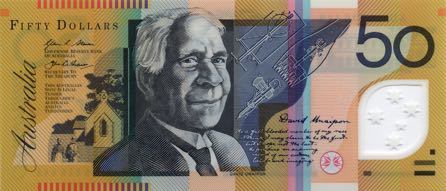
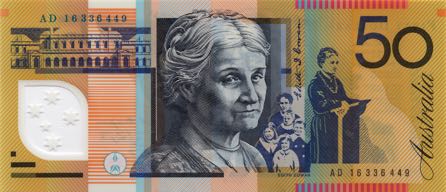
Like B228l, but new date (2016) and new signatures.
Courtesy of Mauricio Diaz-Chavarro.
Australia new 20-dollar note (B232) reported for introduction October 2019
22 02, 2019 07:30 Category: Oceania
According to a press release dated 22 February 2019, the Reserve Bank of Australia plans to introduce a new 20-dollar note (B232) in October 2019.

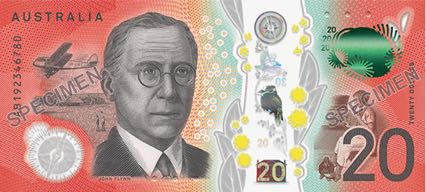


Australia new 50-dollar note (B233a) confirmed introduced 18.10.2018
24 10, 2018 08:58 Category: Oceania
According to a press release, the Reserve Bank of Australia introduced a new 50-dollar note on 18 October 2018.
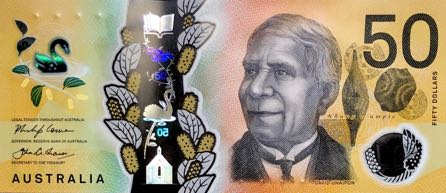
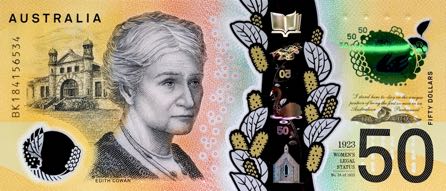
Courtesy of KK Lim ().


Courtesy of KK Lim ().
30% off select chapters of The Banknote Book in print
02 12, 2019 06:43 Category: The Banknote Book
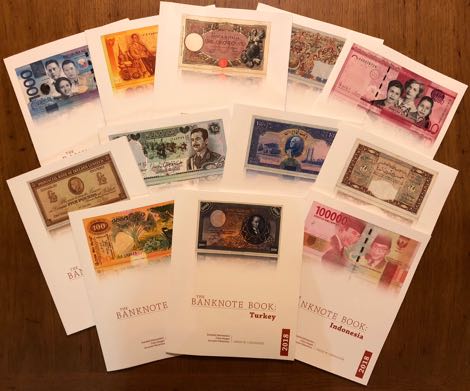
In response to customer demand, 26 of the largest chapters of The Banknote Book are now available in print.
The following chapters can now be ordered in print directly from Lulu.com or Amazon
Algeria
Argentina
Australia
Belgium
Bolivia
Bulgaria
Ceylon
Cuba
Dominican Republic
Egypt
Fiji
Germany
Indonesia
Iran
Iraq
Italy
Japan
Lebanon
Macau
Northern Ireland
Philippines
Romania
Syria
Thailand
Turkey
Venezuela
Prices range from US$24.99 to US$39.99, depending upon length, and all are professionally printed in full color on 80-pound glossy paper as perfect-bound paperback books.
Anyone purchasing from Lulu.com is entitled to a coupon code good for a free download of the PDF version of the chapter (US$9.99 value).
Use coupon code CYBERMONDAY30 when ordering on Lulu to get 15% off the list price for orders placed before midnight 3 December 2019.
Check Lulu's home page for discount codes on books and shipping.
Australia new 50-dollar note (B233) reported for October 2018 introduction
15 02, 2018 09:07 Category: Oceania
According to a 15 February 2018 press release, the Reserve Bank of Australia has unveiled the design of a new 50-dollar polymer note to be introduced in October 2018.
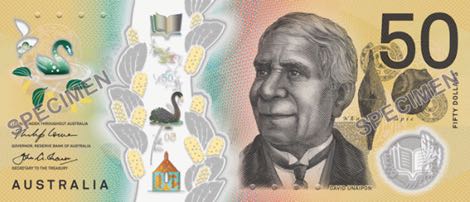
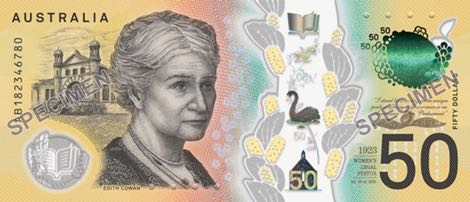
Courtesy of Trevor Wilkin.


Courtesy of Trevor Wilkin.
Australia new 10-dollar note (B231) confirmed introduced 20.09.2017
20 09, 2017 07:55 Category: Oceania
According to a press release, the Reserve Bank of Australia has introduced a new 10-dollar note (B231) on 20 September 2017.

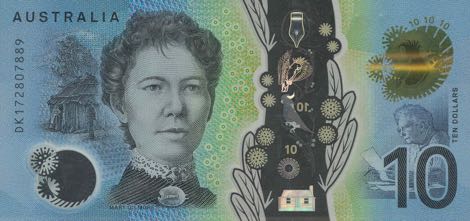
Courtesy of Kai Hwong.


Courtesy of Kai Hwong.
Australia unveils design for new 10-dollar polymer note (B231) due in September 2017
19 02, 2017 13:25 Category: Oceania

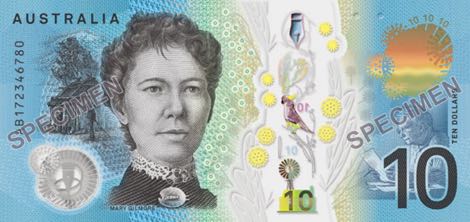
According to a press release dated 17 February 2017, the Reserve Bank of Australia has unveiled the design of the new 10-dollar polymer note scheduled for introduction in September 2017.
Australia new date (2014) 100-dollar note (B229e) confirmed
13 09, 2016 15:37 Category: Oceania
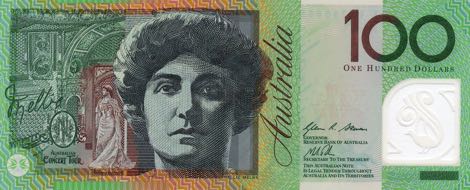
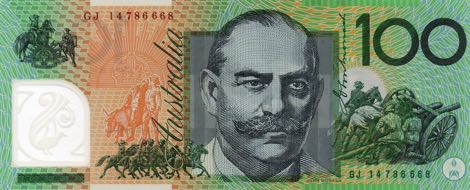
B229e: Like B229d, but new date (2014).
Courtesy of Paul Nahmias.
Australia new sig/date (2015) 5-dollar note (B225j) confirmed
12 09, 2016 17:22 Category: Oceania
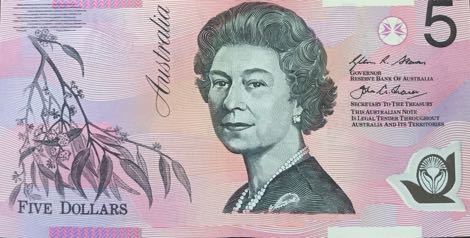

B255j: Like B225h, but new signatures and new date (2015). Prefix BA - EA.
This note dated 2014 is reported by the RBA, but has not yet been confirmed with scans of notes from circulation.
Courtesy of Paul Nahmias.
Australia new 5-dollar note (B230) confirmed
02 09, 2016 11:21 Category: Oceania

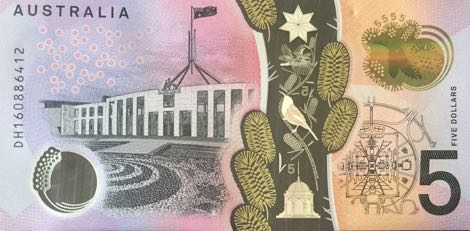
The Reserve Bank of Australia introduced a new polymer 5-dollar note on 1 September 2016, the first in a new series.
Courtesy of Paul Nahmias and Andrew Randall.
Australia new 5-dollar note reported for 01.09.2016 introduction
12 04, 2016 10:27 Category: Oceania
According to a press release dated 12 April 2016, the Reserve Bank of Australia has released images of the new 5-dollar banknote that will be introduced on 1 September 2016.

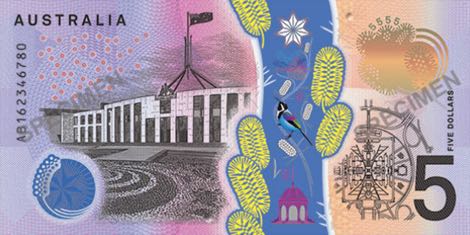
"The images show the basic design artwork of each side of the banknote. As previously announced, key aspects of the existing design – color, size and people portrayed – are retained for ease of recognition and to minimize the disruption to businesses. There is a new ‘tactile’ feature to help the vision-impaired community distinguish between different denominations of banknotes."
Governor Glenn Stevens said, "Innovative new security features have been incorporated to help keep Australia’s banknotes secure from counterfeiting into the future. As can be seen in the images, these include a distinctive top-to-bottom window. Each banknote in the new series will depict a different species of Australian wattle and a native bird within a number of the elements. On the $5 banknote, these are the Prickly Moses wattle and the Eastern Spinebill."


"The images show the basic design artwork of each side of the banknote. As previously announced, key aspects of the existing design – color, size and people portrayed – are retained for ease of recognition and to minimize the disruption to businesses. There is a new ‘tactile’ feature to help the vision-impaired community distinguish between different denominations of banknotes."
Governor Glenn Stevens said, "Innovative new security features have been incorporated to help keep Australia’s banknotes secure from counterfeiting into the future. As can be seen in the images, these include a distinctive top-to-bottom window. Each banknote in the new series will depict a different species of Australian wattle and a native bird within a number of the elements. On the $5 banknote, these are the Prickly Moses wattle and the Eastern Spinebill."
Australia new 5-dollar polymer note to be introduced 01.09.2016
22 02, 2016 13:37 Category: Oceania
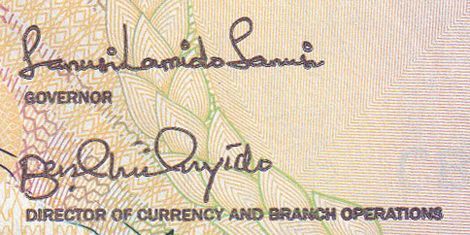
500 naira (US$4.30), 2009. Like P30, but new date, new signatures (Lamido Aminu Sanusi, GOVERNOR; Benjamin C. Onyido, DIRECTOR OF CURRENCY AND BRANCH OPERATIONS), and new titles.
Courtesy of Andrew Roberts.
Australia chapter of The Banknote Book is now complete
17 12, 2015 11:47 Category: The Banknote Book | Oceania
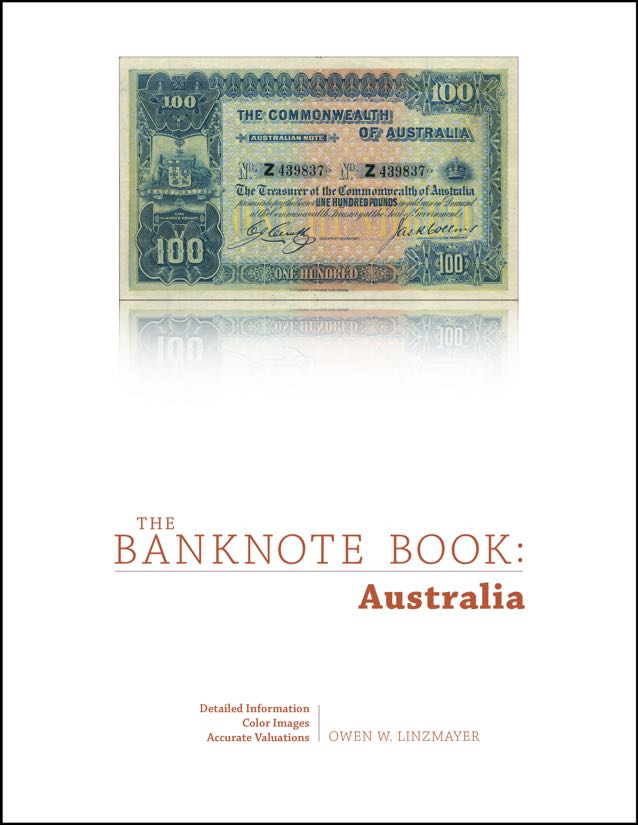
The Australia chapter of The Banknote Book is now available for individual sale and as a free download to subscribers.
This 35-page catalog covers notes issued by the Commonwealth of Australia from 1913 to 1954 and the Reserve Bank of Australia from 1960 to present. Revised 18 December 2015.
Each chapter of The Banknote Book includes detailed descriptions and background information, full-color images, and accurate valuations. The Banknote Book also features:
- Sharp color images of note’s front and back without overlap
- Face value or date of demonetization if no longer legal tender
- Specific identification of all vignette elements
- Security features described in full
- Printer imprint reproduced exactly as on note
- Each date/signature variety assigned an individual letter
- Variety checkboxes for tracking your collection and want list
- Date reproduced exactly as on note
- Precise date of introduction noted when known
- Replacement note information
- Signature tables, often with names and terms of service
- Background information for historical and cultural context
- Details magnified to distinguish between note varieties
- Bibliographic sources listed for further research
Subscribe to The Banknote Book
If you collect the entire world or a large number of countries, buying a subscription is the best deal because it's less expensive than buying chapters individually, and it entitles you to every chapter currently available as well as everything published—or revised (click here to see the Change Log)—during the term of your subscription.

Sign up for Email Notifications
If you would like to receive email notifications whenever a new chapter of The Banknote Book is published, please join the email list by clicking the button below.

Australia's next notes to have features for the vision impaired
20 02, 2015 09:12 Category: Oceania
According to a press release dated 13 February 2015, Glenn Stevens, governor of the Reserve Bank of Australia, "announced that the next generation of Australian banknotes will include a ‘tactile’ feature to assist people with a vision impairment.
As previously announced, existing features to help the vision impaired tell the difference between different denominations of Australian banknotes will be maintained on the new series. These include: bright colours; large and bold numbers; and different sizes for each denomination of banknote. The Bank will also continue to fund the production of the ‘cash test card’. The addition of a ‘tactile’ feature will further assist people with a vision impairment to tell the difference between denominations.
This decision is the culmination of extensive research by the Bank into whether an effective and durable tactile marking could be included on Australian banknotes. This included consultation with the vision impaired community, other stakeholders and overseas central banks.
The testing and trialling process for the next generation of banknotes is ongoing and designs have not yet been finalised. Details about the new designs, the release dates and how they will be issued will be released in a timely way, so that the public can be confident they understand how to recognise and use the new banknotes."
Courtesy of Shane Rivett.
As previously announced, existing features to help the vision impaired tell the difference between different denominations of Australian banknotes will be maintained on the new series. These include: bright colours; large and bold numbers; and different sizes for each denomination of banknote. The Bank will also continue to fund the production of the ‘cash test card’. The addition of a ‘tactile’ feature will further assist people with a vision impairment to tell the difference between denominations.
This decision is the culmination of extensive research by the Bank into whether an effective and durable tactile marking could be included on Australian banknotes. This included consultation with the vision impaired community, other stakeholders and overseas central banks.
The testing and trialling process for the next generation of banknotes is ongoing and designs have not yet been finalised. Details about the new designs, the release dates and how they will be issued will be released in a timely way, so that the public can be confident they understand how to recognise and use the new banknotes."
Courtesy of Shane Rivett.
History of polymer banknotes in Australia
26 11, 2014 09:21 Category: Oceania
The Conversation has published an interesting article on the history of polymer banknotes in Australia.
Austrian note printing firm in scandal involving Azerbaijan and Syria
16 11, 2014 15:21 Category: Europe
A Washington Post article dated 15 November 2014 details the allegations of bribery behind Austria's banknote printing firm, Oesterreichische Banknoten-und Sicherheitsdruck, and its efforts to win bids to produce currency for Azerbaijan and Syria.
Australia announced new date (2013) notes
26 07, 2014 10:20 Category: Oceania
According to a post on the Reserve Bank of Australia web site, all denominations from 5 to 100 dollars have been produced dated (20)13.
Courtesy of Shane McCulloch (www.newcastlecoins.com.au).
Courtesy of Shane McCulloch (www.newcastlecoins.com.au).
Australia paper discussed the Next Generation Banknote Project
22 03, 2014 09:15 Category: Oceania
The Reserve Bank of Australia has published a PDF paper on the Next Generation Banknote Project, RBA's efforts to deter counterfeiting by enhancing the security of Australia's banknotes. One interesting finding is that the Australian public greatly exagerates the likelihood of receiving a counterfeit in circulation even though polymer fakes were virtually non-existent prior to 2010. Since then, rather convincing $50 fakes have been passed, and Mexico's 50-peso note was successfully counterfeited in 2012.
The "NGB" series will maintain the current serie's color schemes and people portrayed, and will also be printed on polymer, but with more complex designs, intaglio and offset printing, multiple see-through windows.
The "NGB" series will maintain the current serie's color schemes and people portrayed, and will also be printed on polymer, but with more complex designs, intaglio and offset printing, multiple see-through windows.
Australian mint releases coins featuring banknote designs
28 05, 2013 22:03 Category: Oceania

According to a post on World Coin News, "The Royal Australian Mint has released this uncirculated three coin set. The coin designs within are inspired by banknote designs originally issued 100 years ago; they feature iconic images of Australia's primary industries of the era. The ten shillings, one pound, and five pounds designs are all celebrated on the coins within this set."
Courtesy of Matt.
Reserve Bank of Australia to sell Securency to Innovia Film
12 02, 2013 10:15 Category: Oceania
According to a BBC News article dated 11 February 2013, the Reserve Bank of Australia has agreed to sell its 50% stake in Securency International for A$65m ($67m; £40m) to UK-based Innovia Films, which already owns the remaining 50%. Securency is the developer of polymer-based Guardian banknote substrate.
Courtesy of Aidan Work.
Courtesy of Aidan Work.
Australia polymer banknote scientist audio interview available online
30 09, 2012 14:38 Category: Oceania
Radio National has an interesting 10-minute interview with David Solomon, an Australian scientist who worked with the Reserve Bank of Australia to create polymer banknotes.
Australia new polymer note concepts cause controversy
29 09, 2012 13:52 Category: Oceania
According to an article in The Australian dated 27 September 2012, the Reserve Bank of Australia has been working on a top-secret project, dubbed Next Generation Bank Note, for the past five years, the goal of which is to issue a new series of polymer banknotes, breathing new life into the currency, helping it capture "characteristics of Australia" with "youthful" and "energetic design qualities" while giving the bank the opportunity to enhance security features.
The following concept banknotes from Melbourne designer Garry Emery were approved for further development in 2010, and show that Queen Elizabeth II had been removed from the 5-dollar note in favor of the father of Federation, Henry Parkes, and Australia's first female political candidate, Catherine Helen Spence. The RBA ultimately decided to keep QEII on this denomination, although final designs have not been chosen, and it will be several years before any new notes are introduced to the public.
The Australian article made such a fuss about the amount of money spent on this project (said to be AU$9.3 million by News Limited), much of it paid to non-Australian designers, that the RBA was forced to issue an official response.
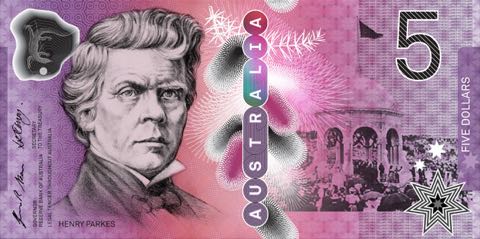
The design brief for the Reserve Bank’s new generation $5 bank note did not initially include the Queen. Instead Father of Federation Sir Henry Parkes was to be the star.
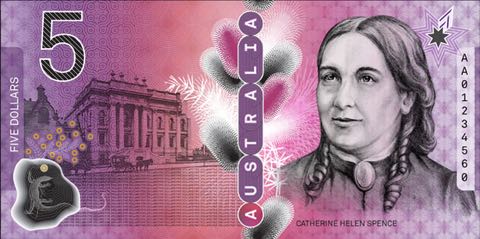
Australia’s first female political candidate Catherine Helen Spence featured on a special commemorative $5 note back in 2001 and was set to return with a new portrait in Gerry Emery’s NGB design.
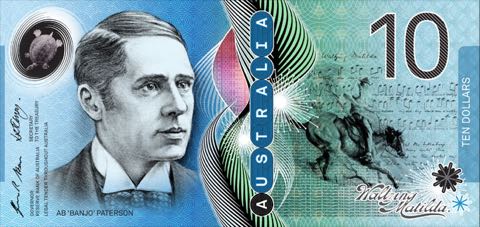
RBA research shows most Australians cannot name the faces on our money. The lyrics to Waltzing Matilda help identify AB 'Banjo' Paterson instantly.

Poets and writers feature heavily on Australian bank notes. The typewritten verse of poet and journalist Dame Mary Gilmore brings a haunting sense of authenticity to Garry Emery's NGB design for the tenner.

Englishwoman Mary Reibey was transported to Australia as a convict but went on to become a successful businesswoman in Sydney. The RBA removed biography captions early on in the NGB project to avoid lecturing the public.

The NGB design brief called for the expression of 'Australian characteristics'. The Reverend John Flynn, who founded what became the Royal Flying Doctor Service, is rendered before a dramatic outback scene.

Allan 'Chirpy' Campbell the great-nephew of Aboriginal inventor and author David Unaipon has vowed to sue the Reserve Bank for $30 million over the 'unauthorised' use of Unaipon in the present $50 note. But he loves this new image.
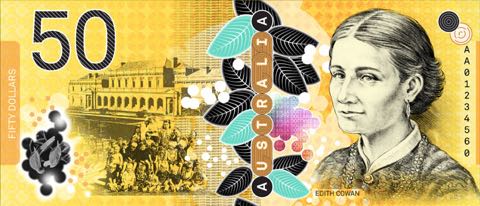
The new portrait of teacher Edith Cowan with outback kids captured a youthful spirit the design brief called for before the Reserve Bank returned to safer territory in later versions.
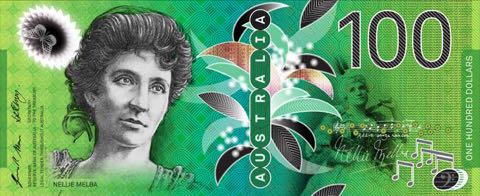
Legendary diva Dame Nellie Melba was set for a spectacular return to her heyday in the new portrait commissioned but we're staying with the older stodgy image of today's $100 note.

Sir John Monash, Australia's greatest general, knocked polar explorer Douglas Mawson off the $100 when our biggest note changed from paper to plastic in 1996.
Courtesy of Thomas Krause, Trevor Wilkin, Yves Courtemanche. Neale Vickery, Allan Tilley, and Aidan Work.
The following concept banknotes from Melbourne designer Garry Emery were approved for further development in 2010, and show that Queen Elizabeth II had been removed from the 5-dollar note in favor of the father of Federation, Henry Parkes, and Australia's first female political candidate, Catherine Helen Spence. The RBA ultimately decided to keep QEII on this denomination, although final designs have not been chosen, and it will be several years before any new notes are introduced to the public.
The Australian article made such a fuss about the amount of money spent on this project (said to be AU$9.3 million by News Limited), much of it paid to non-Australian designers, that the RBA was forced to issue an official response.

The design brief for the Reserve Bank’s new generation $5 bank note did not initially include the Queen. Instead Father of Federation Sir Henry Parkes was to be the star.

Australia’s first female political candidate Catherine Helen Spence featured on a special commemorative $5 note back in 2001 and was set to return with a new portrait in Gerry Emery’s NGB design.

RBA research shows most Australians cannot name the faces on our money. The lyrics to Waltzing Matilda help identify AB 'Banjo' Paterson instantly.

Poets and writers feature heavily on Australian bank notes. The typewritten verse of poet and journalist Dame Mary Gilmore brings a haunting sense of authenticity to Garry Emery's NGB design for the tenner.

Englishwoman Mary Reibey was transported to Australia as a convict but went on to become a successful businesswoman in Sydney. The RBA removed biography captions early on in the NGB project to avoid lecturing the public.

The NGB design brief called for the expression of 'Australian characteristics'. The Reverend John Flynn, who founded what became the Royal Flying Doctor Service, is rendered before a dramatic outback scene.

Allan 'Chirpy' Campbell the great-nephew of Aboriginal inventor and author David Unaipon has vowed to sue the Reserve Bank for $30 million over the 'unauthorised' use of Unaipon in the present $50 note. But he loves this new image.

The new portrait of teacher Edith Cowan with outback kids captured a youthful spirit the design brief called for before the Reserve Bank returned to safer territory in later versions.

Legendary diva Dame Nellie Melba was set for a spectacular return to her heyday in the new portrait commissioned but we're staying with the older stodgy image of today's $100 note.

Sir John Monash, Australia's greatest general, knocked polar explorer Douglas Mawson off the $100 when our biggest note changed from paper to plastic in 1996.
Courtesy of Thomas Krause, Trevor Wilkin, Yves Courtemanche. Neale Vickery, Allan Tilley, and Aidan Work.
Australia new sig/date (2012) 10-dollar note confirmed
04 09, 2012 09:48 Category: Oceania
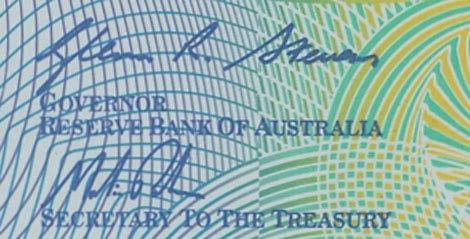
10 dollars (US$10), (20)12. Like P58, but new date and new signatures (Glenn Robert Stevens and Martin Parkinson).
Courtesy of Thomas Krause.
Australia new date (2011) 50- and 100-dollar notes confirmed
09 08, 2012 10:15 Category: Oceania
50 dollars (US$53), (20)11. Like P60, but new date.
100 dollars (US$106), (20)11. Like P61, but new date.
Courtesy of Peter Mosselberger (www.banknote.ws).
100 dollars (US$106), (20)11. Like P61, but new date.
Courtesy of Peter Mosselberger (www.banknote.ws).
Australia new sig/date (2012) 50-dollar note confirmed
23 07, 2012 07:08 Category: Oceania
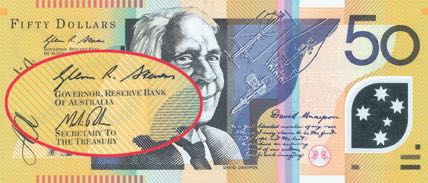

50 dollars (US$52), (20)12. Like P60, but new date and signatures (Glenn Robert Stevens and Martin Parkinson).
Courtesy of Thomas Krause.
Australia new sig/date (2012) 5-dollar note confirmed
22 07, 2012 08:55 Category: Oceania

5 dollars (US$5.20), (20)12. Like P57, but new date and signatures (Glenn Robert Stevens and Martin Parkinson).
Courtesy of Thomas Krause and Glenn Warren.
Australia new date (2010) 20-, 50-, and 100-dollar notes confirmed
04 08, 2011 09:00 Category: Oceania
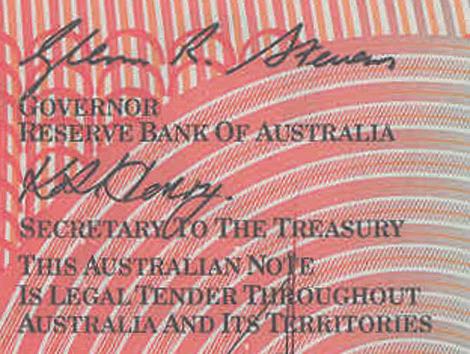
20 dollars (US$21), (20)10. Like P59f, but new date.
50 dollars (US$53), (20)10. Like P60g, but new date.
100 dollars (US$105), (20)10. Like P61a, but new date.
All three denominations have the same signature combination shown above.
Courtesy of Kai.
Australian dated notes confirmed
17 10, 2010 12:01 Category: Oceania


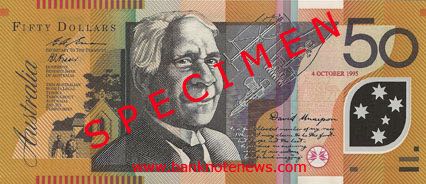

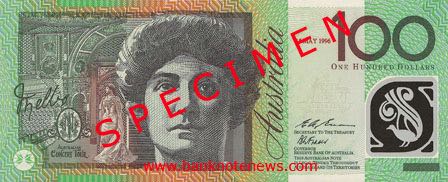

I’ve recently received scans of polymer notes from Australia which differ from the regular issues in that these actually bear full dates overprinted on the notes, rather than just having serial numbers which start with the trailing two digits of the year.
I assume these dates correspond to the dates of introduction for each of these denominations and that the notes were issued as numismatic products, perhaps in a folder or as part of a matched serial number set. Does anyone have any additional information on these notes? If they were in fact issued in folders, please send scans of the folders, inside and out.
Courtesy of Thomas Krause.
New holographic technology has designs on banknote security
06 07, 2010 09:03 Category: Miscellaneous
Technology continues to push the boundaries for banknote security holograms. Here, Dr Glenn Wood of the International Hologram Manufacturers Association looks at some of the latest developments.
Today, holographic technology remains very much to the fore as part of an array of overt features which make it quick and easy for people to recognise whether or not a banknote is bonafide. But new substrate technology, particularly the introduction of transparent ‘windows’ is being incorporated on banknotes to provide new levels of anti-counterfeiting complexity.
The commemorative 1,000 Tenge note produced by Papierfabrik Louisenthal for Kazakhstan and launched earlier this year takes optical sophistication to a new level. Not only does it feature a hologram showing typical rainbow colours but a small microlenticular patch viewed by transmission. The system is called Varifeye® and combines the best features of paper and polymer.

The optically variable feature on the new 1000 Tenge note of Kazakhstan showing microlenticular feature in the window and demetallised hologram below.
Previously, a deckle-edge window was created in the paper substrate during the process of cylinder-mould web formation as the stock fibers collect against the deckle, leading to the characteristic feather look. Latterly, the window has been cut into the paper after laminating to a polymeric layer. Then a clear stripe of film is laminated over it running from top to bottom of the note. The clear stripe contains the microlenticular image of a camel interchanging with the letter ‘K’ when tilted.
This feature can be viewed by transmission through the window. There is also a demetallised holographic image of the Astana Baiterek monument above the text ‘Organisation for Security & Co-operation in Europe’, interchanging with the date 2010 which are viewed by reflection where it falls over the paper. (This technology was first used on the Bulgarian lev banknotes in 2005, becoming the world’s first paper notes with see through window).
For polymeric substrates, the Bank of Australia has developed its Non-diffractive Switching Image (NSI). This appears like a dynamic watermark in the clear window of a polymer-based note. Being non-diffractive, the images are seen in varying shades of grey rather than rainbow colours and switching of the image elements occurs by rotation rather than tilting.
Mexico has also embraced new technology – the country’s 100 peso note has an ingenious feature which outwardly looks holographic but is in fact transparent optically variable inks (they are usually opaque) printed on the clear window of a polymer note. The viewer can look at the feature either by transmission or reflection. The inks change colour in both modes but the colours seen by transmission are the complementary colours of those seen by reflection.
The latest innovation in holographic technology which makes use of traditional (though modified) embossing technology is the Asterium feature from Toppan printing in Japan. Viewed in normal direct light this feature appears black but when inclined at an extreme angle, the rainbow colours of an embossed hologram appear. The important feature here is the optical black which gives a new aesthetic to documents and only reveals the colourful security feature as and when required.

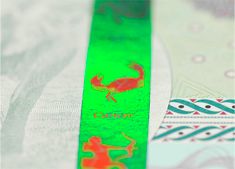
Asterium from Toppan uses optical black in conjunction with a hologram.
Another innovator, Kurz, has developed a revolutionary wafer thin security photopolymer which can record a volume holographic image for banknotes produced for Swiss National Bank. Kurz’s success has been to develop the material thin enough for use on a banknote, especially given that the reason this is called a ‘volume’ hologram is that the interference fringes are recorded within the depth of the photo-sensitive material. Similar developments are taking place in Japan where Dai Nippon Printing is leading the way.
OVD Kinegram, a division of Leonhard Kurz, continues to push the boundaries with its Kinegram reColor®. This has been developed for use as a laminate in conjunction with a window or aperture in the banknote substrate, and provides fundamentally different, and unexpected, effects depending on whether the note is viewed from the front or reverse. On the front the viewer sees a normal metallised reflective, diffractive image, while the reverse view shows a patterned coloured foil also displaying the diffractive features. The trick is performed using different coloured resist lacquers in the demetallization process. More remarkable still is Kinegram reView® which appears the same, metallic color on both sides of the image although the images seen on the two faces can be different and unrelated to each other.
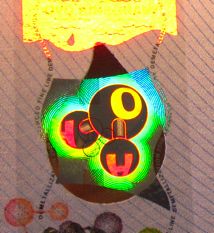
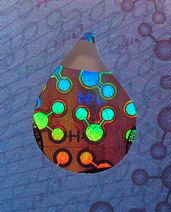
ReView from L. Kurz displays different holographic images when viewed from opposite side of a window.
One way or another, it seems that the window technology now becoming available to printers of banknotes is here to stay. Formerly, the opaque nature of security printing paper only allowed a watermark to be seen by transmission but most holograms are, by nature, transmissive and are rendered reflective by applying a metal coating. Once the opportunity is presented to allow them to be seen by transmission, as in a window, the opportunities for an optical tour de force are increased. This renders the note more visually attractive to inspectors and consumers and more difficult to simulate by counterfeiters.
However, here’s a cautionary word. Any trend towards simplification must be seen as a move in the right direction and run hand in hand with artists and graphic designers’ abilities to make good use of the media or of the public’s ability to appreciate and evaluate the security benefits offered by the latest technology. After all, it’s not as though holograms represent the only security feature on a banknote.
They are often one of many - for example, the 1000 Tenge note for Kazakhstan has at least 16 features including one to help the blind or partially sighted. So, it isn’t necessary to fill the hologram with every conceivable feature rather remember why the hologram was originally introduced: it provided a feature that could not be photocopied. Photopolymers provide this, so there’s no reason to suppose that holographic technology will not continue to be an integral security feature on future generations of banknotes.
END
The International Hologram Manufacturers Association (IHMA) is made up of 90 of the world's leading hologram companies. IHMA members are the leading producers and converters of holograms for banknote security, anti-counterfeiting, brand protection, packaging, graphics and other commercial applications around the world. IHMA member companies actively cooperate to maintain the highest professional, security and quality standards.
Issued on behalf of the IHMA by Mitchell Halton Watson Ltd. For further details contact Andy Bruce on +44 (0) 191 233 1300 or email andy@mhwpr.co.uk
Today, holographic technology remains very much to the fore as part of an array of overt features which make it quick and easy for people to recognise whether or not a banknote is bonafide. But new substrate technology, particularly the introduction of transparent ‘windows’ is being incorporated on banknotes to provide new levels of anti-counterfeiting complexity.
The commemorative 1,000 Tenge note produced by Papierfabrik Louisenthal for Kazakhstan and launched earlier this year takes optical sophistication to a new level. Not only does it feature a hologram showing typical rainbow colours but a small microlenticular patch viewed by transmission. The system is called Varifeye® and combines the best features of paper and polymer.

The optically variable feature on the new 1000 Tenge note of Kazakhstan showing microlenticular feature in the window and demetallised hologram below.
Previously, a deckle-edge window was created in the paper substrate during the process of cylinder-mould web formation as the stock fibers collect against the deckle, leading to the characteristic feather look. Latterly, the window has been cut into the paper after laminating to a polymeric layer. Then a clear stripe of film is laminated over it running from top to bottom of the note. The clear stripe contains the microlenticular image of a camel interchanging with the letter ‘K’ when tilted.
This feature can be viewed by transmission through the window. There is also a demetallised holographic image of the Astana Baiterek monument above the text ‘Organisation for Security & Co-operation in Europe’, interchanging with the date 2010 which are viewed by reflection where it falls over the paper. (This technology was first used on the Bulgarian lev banknotes in 2005, becoming the world’s first paper notes with see through window).
For polymeric substrates, the Bank of Australia has developed its Non-diffractive Switching Image (NSI). This appears like a dynamic watermark in the clear window of a polymer-based note. Being non-diffractive, the images are seen in varying shades of grey rather than rainbow colours and switching of the image elements occurs by rotation rather than tilting.
Mexico has also embraced new technology – the country’s 100 peso note has an ingenious feature which outwardly looks holographic but is in fact transparent optically variable inks (they are usually opaque) printed on the clear window of a polymer note. The viewer can look at the feature either by transmission or reflection. The inks change colour in both modes but the colours seen by transmission are the complementary colours of those seen by reflection.
The latest innovation in holographic technology which makes use of traditional (though modified) embossing technology is the Asterium feature from Toppan printing in Japan. Viewed in normal direct light this feature appears black but when inclined at an extreme angle, the rainbow colours of an embossed hologram appear. The important feature here is the optical black which gives a new aesthetic to documents and only reveals the colourful security feature as and when required.


Asterium from Toppan uses optical black in conjunction with a hologram.
Another innovator, Kurz, has developed a revolutionary wafer thin security photopolymer which can record a volume holographic image for banknotes produced for Swiss National Bank. Kurz’s success has been to develop the material thin enough for use on a banknote, especially given that the reason this is called a ‘volume’ hologram is that the interference fringes are recorded within the depth of the photo-sensitive material. Similar developments are taking place in Japan where Dai Nippon Printing is leading the way.
OVD Kinegram, a division of Leonhard Kurz, continues to push the boundaries with its Kinegram reColor®. This has been developed for use as a laminate in conjunction with a window or aperture in the banknote substrate, and provides fundamentally different, and unexpected, effects depending on whether the note is viewed from the front or reverse. On the front the viewer sees a normal metallised reflective, diffractive image, while the reverse view shows a patterned coloured foil also displaying the diffractive features. The trick is performed using different coloured resist lacquers in the demetallization process. More remarkable still is Kinegram reView® which appears the same, metallic color on both sides of the image although the images seen on the two faces can be different and unrelated to each other.


ReView from L. Kurz displays different holographic images when viewed from opposite side of a window.
One way or another, it seems that the window technology now becoming available to printers of banknotes is here to stay. Formerly, the opaque nature of security printing paper only allowed a watermark to be seen by transmission but most holograms are, by nature, transmissive and are rendered reflective by applying a metal coating. Once the opportunity is presented to allow them to be seen by transmission, as in a window, the opportunities for an optical tour de force are increased. This renders the note more visually attractive to inspectors and consumers and more difficult to simulate by counterfeiters.
However, here’s a cautionary word. Any trend towards simplification must be seen as a move in the right direction and run hand in hand with artists and graphic designers’ abilities to make good use of the media or of the public’s ability to appreciate and evaluate the security benefits offered by the latest technology. After all, it’s not as though holograms represent the only security feature on a banknote.
They are often one of many - for example, the 1000 Tenge note for Kazakhstan has at least 16 features including one to help the blind or partially sighted. So, it isn’t necessary to fill the hologram with every conceivable feature rather remember why the hologram was originally introduced: it provided a feature that could not be photocopied. Photopolymers provide this, so there’s no reason to suppose that holographic technology will not continue to be an integral security feature on future generations of banknotes.
END
The International Hologram Manufacturers Association (IHMA) is made up of 90 of the world's leading hologram companies. IHMA members are the leading producers and converters of holograms for banknote security, anti-counterfeiting, brand protection, packaging, graphics and other commercial applications around the world. IHMA member companies actively cooperate to maintain the highest professional, security and quality standards.
Issued on behalf of the IHMA by Mitchell Halton Watson Ltd. For further details contact Andy Bruce on +44 (0) 191 233 1300 or email andy@mhwpr.co.uk
Australia new date (2009) 50-dollar note confirmed
28 05, 2010 07:36 Category: Oceania
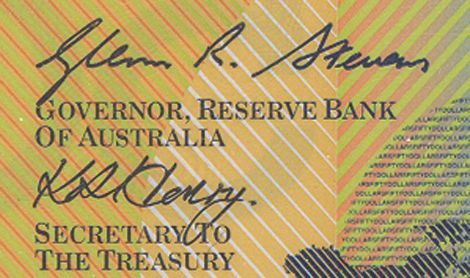
50 dollars (US$42.35), (20)09. Like P60, but new date.
Courtesy of Kai Hwong.
Documentary on Reserve Bank of Australia's bribery scandal
24 05, 2010 16:28 Category: Oceania
Four Corners has produced a documentary, Dirty Money, that explores how the central pillar of Australia’s financial system, the Reserve Bank, became ensnared in an international bribery scandal related to its polymer substrate subsidiary’s attempts to gain contracts around the world.
Courtesy of Kai Hwong.
Courtesy of Kai Hwong.
Australia new date (2008) 10-dollar note confirmed
12 10, 2009 12:56 Category: Oceania
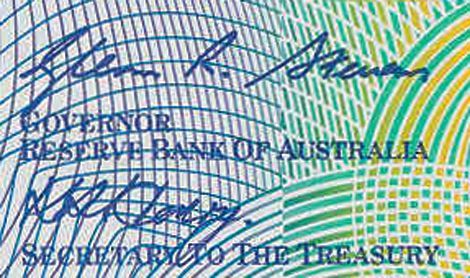
10 dollars (US$9). Like Pick 58, but new date (20)08 and new signatures.
Courtesy of Kai Hwong.
Australia new date (2008) 5-dollar note confirmed
11 10, 2009 15:26 Category: Oceania
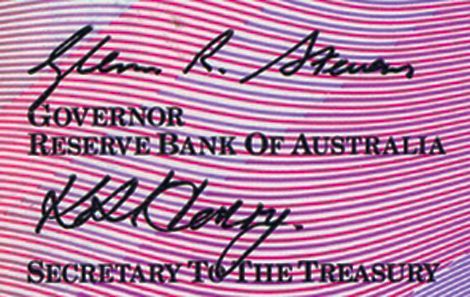
5 dollars (US$4.50). Like Pick 57, but new date (20)08 and new signatures.
Courtesy of TDS.
Australia new date (2008) 20-dollar note confirmed
30 06, 2009 18:04 Category: Oceania
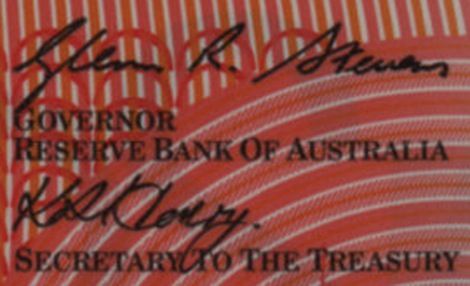
20 dollars (US$16.10), (20)08. Like Pick 59, but new date and new signatures (Glenn R. Stevens, Governor; Dr. Ken Henry, Secretary to the Treasury).
The Reserve Bank of Australia has apparently printed all denominations dated 2008, so all will eventually appear in circulation, though only the 20-, 50-, and 100-dollar notes have been confirmed to date.
Courtesy of Scott de Young.
Australia new date (2008) 100-dollar note confirmed
04 05, 2009 07:07 Category: Oceania
100 dollars (US$73), (20)08. Like Pick 55, but new date and new signatures (Glenn R. Stevens, Governor; Dr. Ken Henry, Secretary To The Treasury).
Courtesy of Christof Zellweger.
Courtesy of Christof Zellweger.
Portrait on Australian $50 used without permission?
04 12, 2008 11:31 Category: Oceania
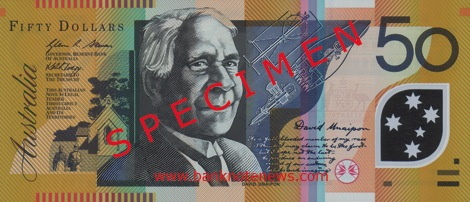
According to a Telegraph article dated 28 November 2008, Allan "Chirpy" Campbell claims the Reserve Bank of Australia gained permission to use the image of celebrated indigenous author and inventor David Unaipon from a woman who was posing as his daughter, and did not obtain authorisation from a genuine family member.
"They jacked this woman up and proclaimed that she is the daughter of my uncle, and when we found out they blocked us and they chucked all the barricades there," he told the Australian Broadcasting Corporation (ABC).
"We are the family, I had to produce my genealogy, I had to produce my documents and documentation, they don't have to, they just say it, and they accepted it."
Mr Campbell, 61, travelled to Sydney this week to make his case for compensation to the Reserve Bank.
The bank, which has so far denied Mr Campbell's demands, refused to comment on the three-hour meeting, but made it known that it believes the appropriate advances to Mr Unaipon's family were made at the time the note was designed.
However, it is understood that those agreements were verbal and no official document of permission exists.
Mr Campbell, a lifelong campaigner for Aboriginal rights, has said he is willing to take the matter to court to obtain a "fair dinkum settlement". If successful, he plans to use the $30 million to start a charity for mentally ill children.
"They've got to renegotiate this time a proper settlement, not a tea leaf, sugar and flour syndrome, you know," he said.
"They've got no proof, no papers to show she is his daughter."
David Unaipon was Australia's first published indigenous author, an inventor and preacher from the Ngarrindjeri people of South Australia.
He held a patent for a sheep shearing mechanism that is depicted beside him on the $50 note.
In his work as a preacher, Mr Unaipon travelled widely and became well-known throughout Australia.
He lectured on Aboriginal legends and customs and also spoke of the need for "sympathetic co-operation" between whites and blacks, and for equal rights for all Australians.
He died in 1967. His image appeared on the $50 note from 1995 when the polymer bill was introduced.
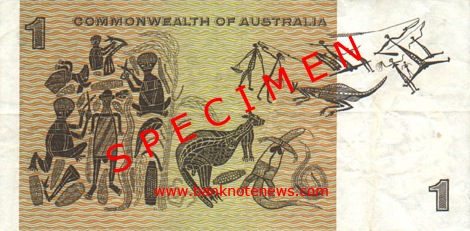
The Unaipon case echoes the use, in 1966, of a bark painting by Arnhem Land artist David Malangi on the $1 note. It later emerged the artwork was reproduced without permission. Mr Malangi was compensated $1,000, a fishing kit and a silver medal.
Australia new date (2008) 50-dollar note confirmed
18 11, 2008 07:57 Category: Oceania

50 dollars (US$47.95), (20)08. Like P60, but new date and new signatures (Glenn R. Stevens, Governor; Dr. Ken Henry, Secretary To The Treasury).
Courtesy of Scott de Young.
Australia new date (2007) 20-dollar note confirmed
18 11, 2007 08:59 Category: Oceania
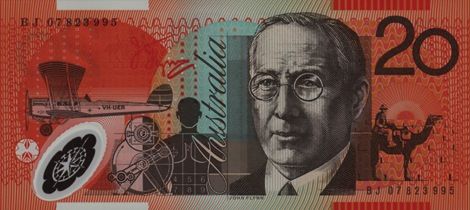
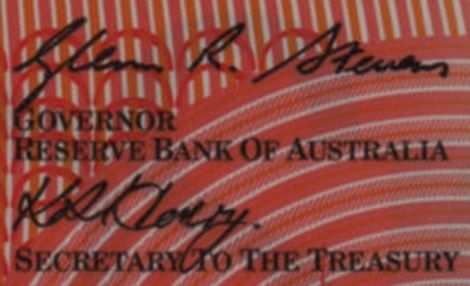
20 dollars (US$17.85), (20)07. Like SCWPM 59, but new date and new signatures (Glenn R. Stevens, Governor; Dr. Ken Henry, Secretary to the Treasury).
Courtesy of Frank Robinson.
Australia new dates (2005 and 2006) confirmed
28 12, 2006 09:38 Category: Oceania
5 dollars (US$3.95), (20)05. Like Pick 57, but new date. Signatures (I. Macfarlane, Governor; Henry, Secretary). Serial DD. Polymer.
10 dollars (US$7.90), (20)06. Like Pick 58, but new date. Signatures (I. Macfarlane, Governor; Henry, Secretary). Serial BH. Polymer.
20 dollars (US$15.80), (20)05. Like Pick 59, but new date. Signatures (I. Macfarlane, Governor; Henry, Secretary). Serial CJ. Polymer.
50 dollars (US$39.45), (20)05. Like Pick 60, but new date. Signatures (I. Macfarlane, Governor; Henry, Secretary). Serial HE. Polymer.
10 dollars (US$7.90), (20)06. Like Pick 58, but new date. Signatures (I. Macfarlane, Governor; Henry, Secretary). Serial BH. Polymer.
20 dollars (US$15.80), (20)05. Like Pick 59, but new date. Signatures (I. Macfarlane, Governor; Henry, Secretary). Serial CJ. Polymer.
50 dollars (US$39.45), (20)05. Like Pick 60, but new date. Signatures (I. Macfarlane, Governor; Henry, Secretary). Serial HE. Polymer.
Australia’s Reserve Bank annual report findings
30 09, 2007 12:06 Category: Oceania
Australia’s Reserve Bank annual report findings Read More...

